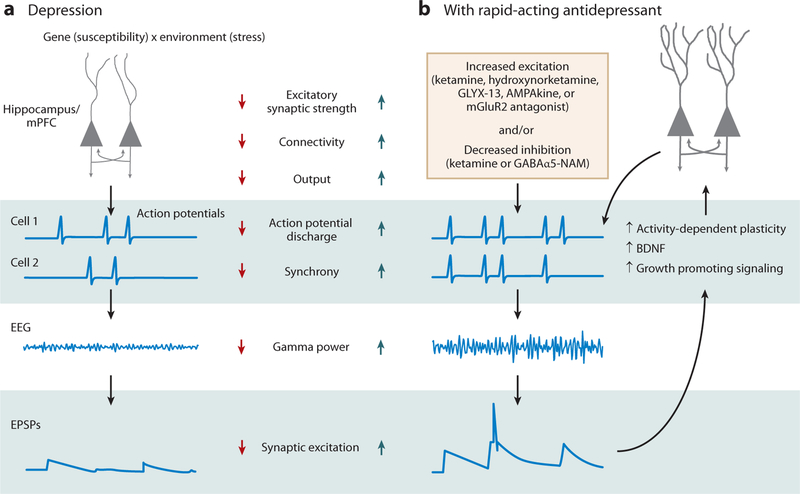Figure 3.

Neurophysiological mechanisms of rapid-acting antidepressant action. (a) Depression susceptibility is modulated by genetic risk and exposure to environmental factors, such as chronic stress. Such factors are proposed to interact to cause dendritic atrophy and decreased synaptic function in key circuits within the corticomesolimbic structures illustrated in Figure 2, thereby contributing to the symptoms of depression. These defects have the net effect of reducing neuronal output, weakening connectivity within and between circuit nodes, and decreasing synchronous action potential discharge, which can be detected as decreases in coherent oscillations with EEG. Decreased synchronous coherent activity will act to reduce synaptic strength. (b) Rapid-acting antidepressants are proposed to counteract these changes either by acutely increasing overall excitation, as do hydroxynorketamines, mGluR2 antagonists, AMPAkines, or GLYX-13, or by acutely decreasing synaptic inhibition, as do ketamine, GABAα5-NAMs or scopolamine. This shift in the balance of excitation and inhibition favors synchronous discharge, apparent as increased gamma power oscillations in the EEG, and strong synaptic excitation. Strong synaptic excitation, in turn, triggers the activation of long-term potentiation and a range of cellular growth–associated signaling cascades, including synthesis and release of BDNF, activation of mTORC1, and dephosphorylation of eEF2K, all of which act synergistically to restore dendritic strength, promote synaptogenesis, and strengthen excitatory connections, thereby restoring the function of the reward circuitry and relieving the symptoms of depression. Abbreviations: BDNF, brain-derived neurotrophic factor; eEF2K, eukaryotic elongation factor-2 kinase; EEG, electroencephalography; EPSPs, excitatory postsynaptic potentials; GABA, γ-aminobutyric acid; GABAα5-NAMs, GABA α5 receptor negative allosteric modulators; mTORC1, mechanistic target of rapamycin complex 1.
